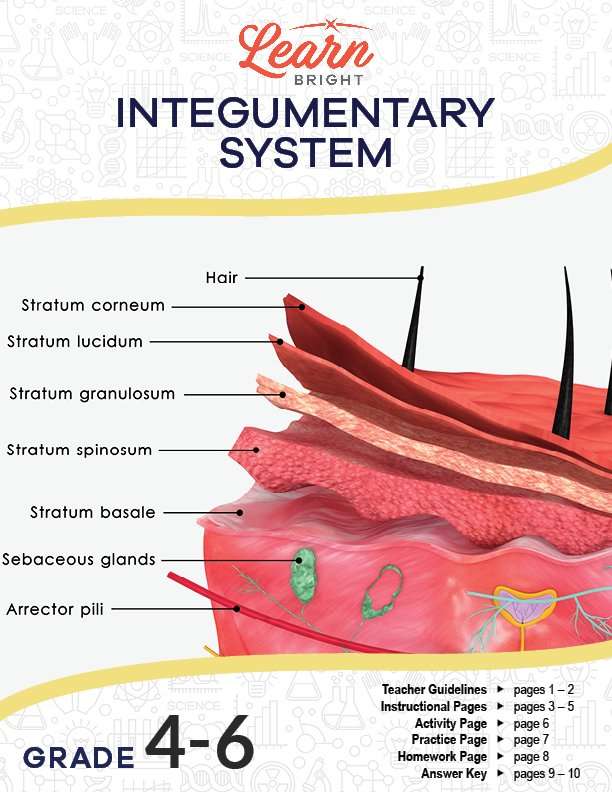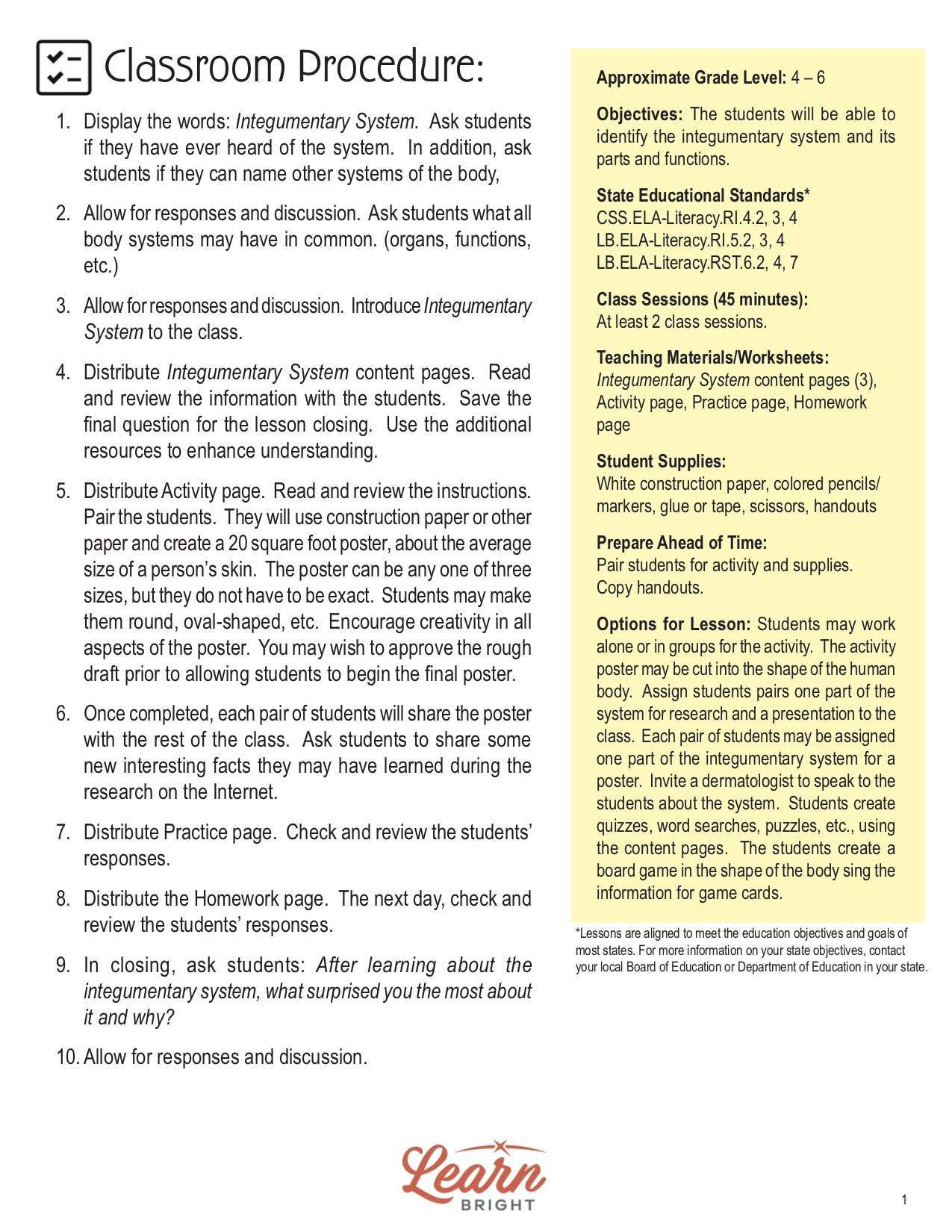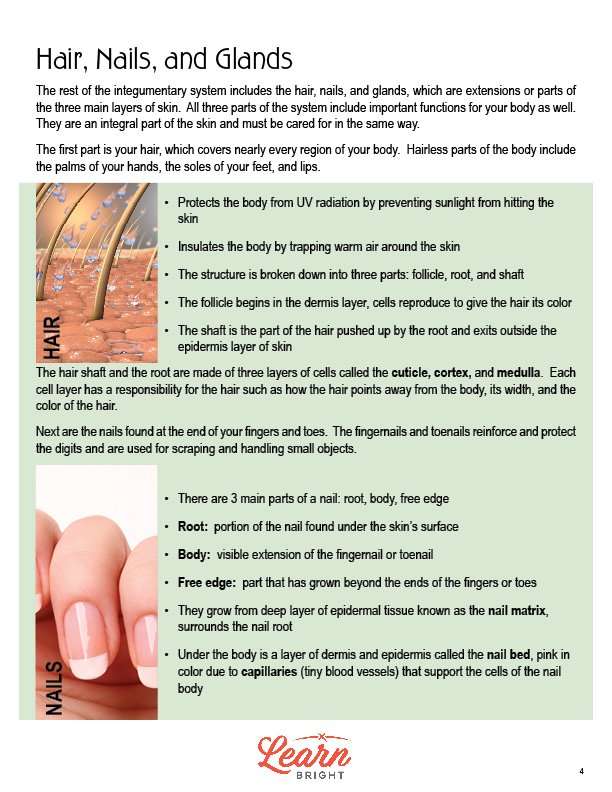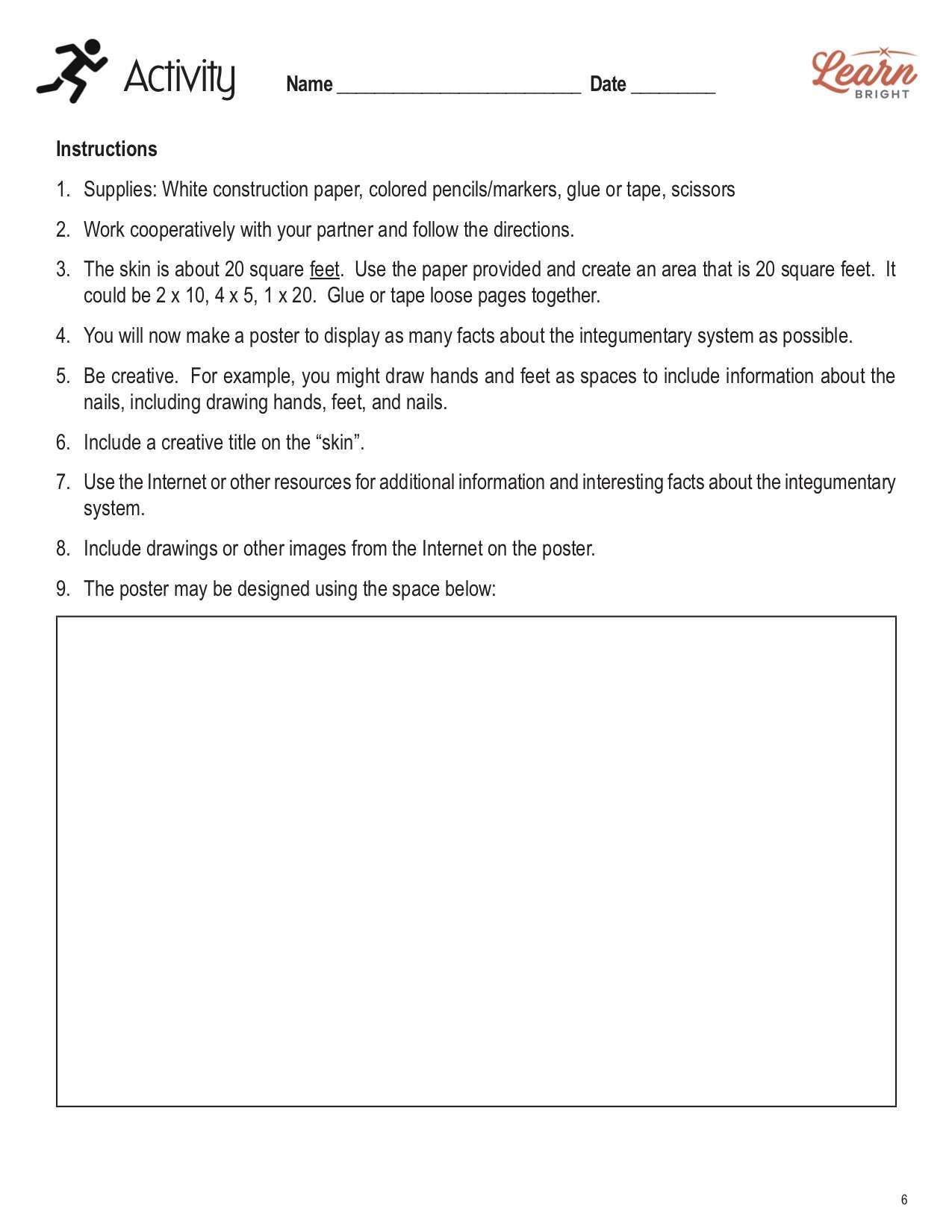Description
What our Integumentary System lesson plan includes
Lesson Objectives and Overview: Integumentary System teaches students about the parts and functions of this body system. Students will discover that the skin, hair, nails, and exocrine glands are all parts of this system. They will learn specific facts about each of these features. By the end, they will be able to identify the parts and functions of the integumentary system. This lesson is for students in 4th grade, 5th grade, and 6th grade.
Classroom Procedure
Every lesson plan provides you with a classroom procedure page that outlines a step-by-step guide to follow. You do not have to follow the guide exactly. The guide helps you organize the lesson and details when to hand out worksheets. It also lists information in the yellow box that you might find useful. You will find the lesson objectives, state standards, and number of class sessions the lesson should take to complete in this area. In addition, it describes the supplies you will need as well as what and how you need to prepare beforehand.
Options for Lesson
The “Options for Lesson” section lists several ideas for additional activities and tasks to incorporate if you want to extend it. One suggestion is to assign pairs of students one part of the integumentary system to research and later present to the class. You could also assign pairs of students one part of the system to create a poster about as an additional activity. Invite a dermatologist to speak with the class and answer their questions about skin. Another fun idea is to have students create quizzes or puzzles using the information from the content pages. They could also create a board game in the shape of the body and use information from the lesson to make game cards.
Teacher Notes
This page provides a paragraph of extra information or guidance for the lesson. It reminds you that this lesson is an overview and doesn’t cover every detail. The main objective is to educate students on the basics of the integumentary system and the functions of its parts. You could teach this lesson in conjunction with others about the human body. You can use the blank lines on this page to write out thoughts or ideas you have as you prepare.
INTEGUMENTARY SYSTEM LESSON PLAN CONTENT PAGES
The Skin and Its Functions
The Integumentary System lesson plan contains three content pages. Students will first learn that the human body consists of several systems, such as the respiratory, circulatory, and nervous systems. Every system uses a number of body parts like organs, muscles, bones, and nerves. The integumentary system claims the largest organ in the body—the human skin.
Human skin is only a few millimeters thick. For an average person, the total weight of their skin is about 10 pounds, and its surface area is about 20 square feet. Along with skin, the integumentary system includes hair, nails, and exocrine glands. The skin covers and protects the body from chemicals, disease, and other physical damage. The hair and nails are extensions of the skin and help reinforce and protect our bodies from environmental damage as well. The exocrine glands, finally, produce sweat as well as wax to keep the skin’s surface cool, protect it, and moisturize its surface.
The skin’s functions include temperature control, keeping the body typically around 98.6°F. It also helps warm the body with goosebumps in cold weather. In addition, the thickness of the skin on the soles of the feet is greater because feet get rubbed more often. Similarly, the skin on our palms is much firmer because it makes it easier to grasp things.
Layers of Skin
There are multiple layers of the skin. The epidermis is the outer layer, and protection is its main purpose. New cells constantly grow deep inside to replace the 30,000 to 40,000 dead skin cells that fall off the body each year. They then come to the surface containing keratin, helping make the skin tough and waterproof. Other cells produce melanin, which darkens the skin and protects it from UV rays.
The dermis is the second layer, which is thicker and more elastic. It is home to the skin’s follicles and glands. This layer also contains nerves and blood vessels. The nerves, part of the nervous system, have sensors that send messages to and from the brain and help us feel things. The blood vessels, which are part of the circulatory system, carry oxygen and nutrients to the cells and carry away waste.
The hypodermis, also called the subcutaneous layer, is mostly made of fat. It helps keep the body warm and absorbs shocks to the body. This layer holds all the skin cells to the tissues beneath it. It is the connection between the skin and the muscles and bones below.
Hair and Nails
Students will next learn about the remaining parts of the integumentary system. In humans, hair covers nearly every region of the body. Some of the only places that don’t have hair include the palms of the hands, soles of the feet, and the lips. Hair provides important functions just as the skin does and as an equally integral part of the skin.
Hair protects the body from UV radiation by preventing sunlight from hitting the skin. It insulates the body by trapping warm air around the skin. Its structure is broken down into three parts: follicle, root, and shaft. The follicle begins in the dermis layer. Cells reproduce to give the hair its color.
The shaft is the part of the hair that is pushed up by the root. It exists outside the epidermis layer of skin. The root of a strand of hair consists of three layers of cells called the cuticle, cortex, and medulla. Each cell layer has a responsibility, such as how the hair points away from the body. It also controls the width of the hair and the color.
Nails, found at the ends of fingers and toes, reinforce and protect the digits and help us scrape or handle small objects. There are three main parts of a nail: the root, the body, and the free edge. The root is under the skin’s surface, the body is the visible extension, and the free edge is the part that grows beyond the ends of fingers or toes.
The lesson explains that nails grow from a deep layer of epidermal tissue known as the nail matrix, which surrounds the nail root. Under the body of the nail is a layer of dermis and epidermis called the nail bed. It’s usually pink in color due to the capillaries that support the cells of the nail body. Like the hair and skin, it is important to keep the nails clean, too. They are places where bacteria and other infection-causing organisms grow and cause issues.
Exocrine Glands of the Integumentary System
There are three main exocrine glands: sudoriferous, subaceous, and ceruminous. They all exist in the dermis layer of our skin. Each has special functions for the body. The sudoriferous glands are more commonly known as sweat glands, and there are two major types—eccrine and apocrine.
Eccrine glands are nearly everywhere on the skin. They produce a secretion of water and salt that the body uses to lower its temperature through evaporative cooling. Apocrine glands are mainly in the armpits and pubic regions of the body. They extend into the follicles of hair so that sweat can exit the body along the surface of the hair shaft. These glands are inactive until a person reaches puberty.
Sebaceous glands produce sebum, which is a type of oil that helps keep the body soft and waterproof. Without it, water would be able to permeate the body. These glands are found in every part of the skin except for the palms of the hands and soles of the feet.
Finally, the ceruminous glands, found in the ear canals, produce a waxy secretion called cerumen, or ear wax. Cerumen protects ear canals and lubricates the ear drum. It also traps dust and other airborne particles that enter the canal. The glands produce cerumen continuously and push older ear wax out.
Key Terms
Here is a list of the vocabulary words students will learn in this lesson plan:
- Integumentary system—the body system that includes the skin, hair, nails, and exocrine glands
- Exocrine glands—the glands that produce sweat and wax to keep the skin’s surface cool, to protect the skin, and to moisturize the skin’s surface
- Keratin—a substance produced by new skin cells to help make the skin tough and waterproof
- Melanin—a pigment that cells produce that darkens skin and protects it from UV rays
- Sebum—an oil that keeps the skin soft and waterproof
- Cerumen—ear wax produced by the ceruminous glands to protect the ear canal and lubricate the ear drum
INTEGUMENTARY SYSTEM LESSON PLAN WORKSHEETS
The Integumentary System lesson plan includes three worksheets: an activity worksheet, a practice worksheet, and a homework assignment. Each one helps reinforce students’ comprehension of the things they learned throughout the lesson. The guidelines on the classroom procedure page describe when to hand out each worksheet.
CREATIVE POSTER ACTIVITY
Students will work with a partner for the activity. The worksheet outlines instructions for creating a poster that is 20 square feet. Each pair of students will then add as many details about the system as possible. They will need to get creative in whatever ways they can, like drawing hands and feet. Additionally, they need to add a creative title.
MATCH THE DEFINITIONS PRACTICE WORKSHEET
For the practice worksheet, students must match definitions to the correct terms. There are 20 definitions to match to the terms in the word bank on the right side of the worksheet.
INTEGUMENTARY SYSTEM HOMEWORK ASSIGNMENT
There are two sections of the homework assignment. The first section requires students to circle the correct choice in a series of 10 statements. There are three options for each statement. For the second section, students will answer each question. There are a total of 12 questions.
Worksheet Answer Keys
The last couple pages of this PDF are answer keys for practice and homework worksheets. All the correct answers are in red, which makes it easier for you to compare them to your students’ work. There should not be any variation in student responses apart from a couple of the questions in the second part of the homework assignment. If you choose to administer the lesson pages to your students via PDF, you will need to save a new file that omits these pages. Otherwise, you can simply print out the applicable pages and keep these as reference for yourself when grading assignments.









